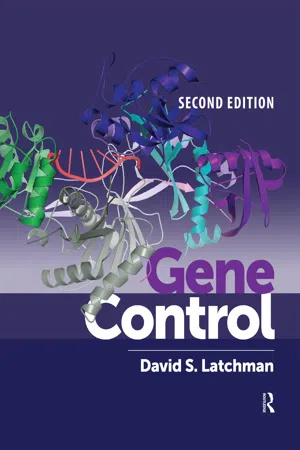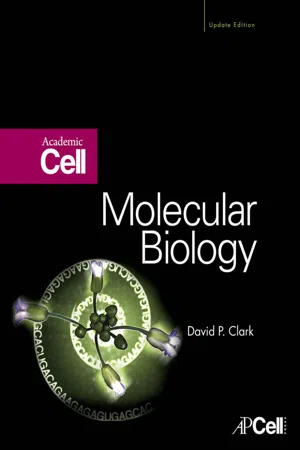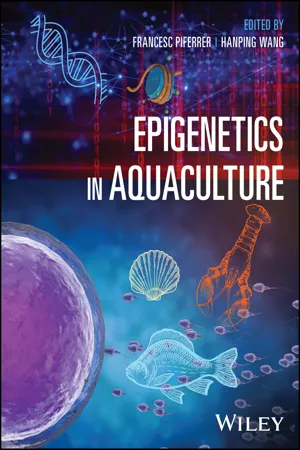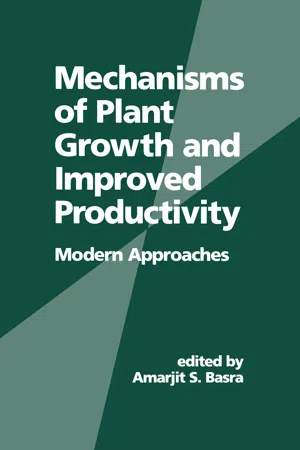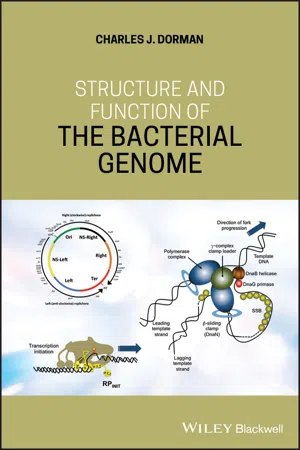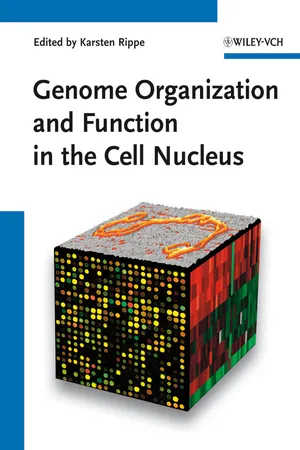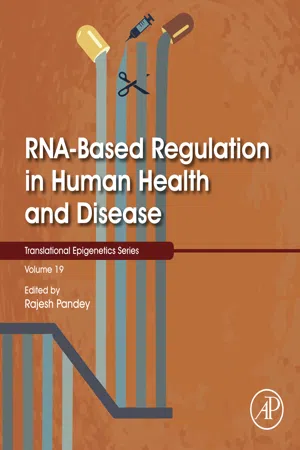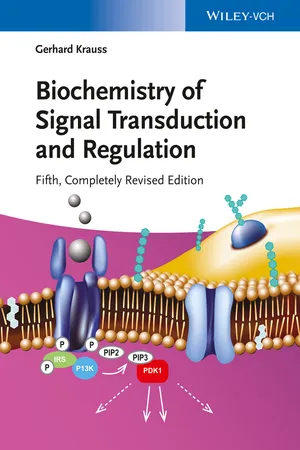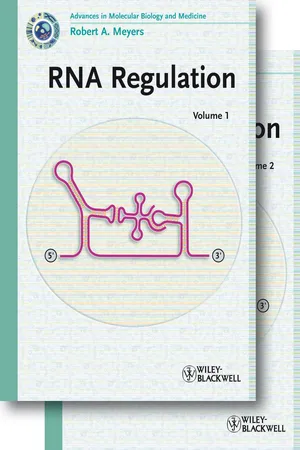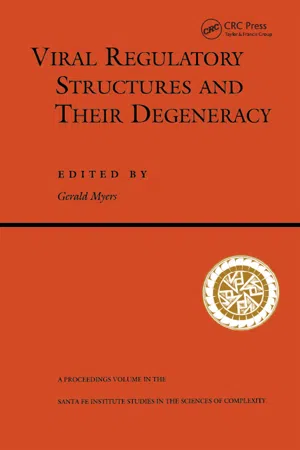Biological Sciences
Post-Transcriptional Regulation
Post-transcriptional regulation refers to the control of gene expression that occurs after the transcription of DNA into RNA. This process involves various mechanisms such as RNA splicing, RNA editing, and mRNA stability, which influence the final amount and functionality of proteins produced by the cell. Post-transcriptional regulation plays a crucial role in fine-tuning gene expression and maintaining cellular homeostasis.
Written by Perlego with AI-assistance
Related key terms
Related key terms
1 of 4
Related key terms
1 of 3
11 Key excerpts on "Post-Transcriptional Regulation"
- Buddhi Prakash Jain, Shyamal K Goswami, Tapan Sharma, Buddhi Prakash Jain, Shyamal K Goswami, Tapan Sharma(Authors)
- 2022(Publication Date)
- Academic Press(Publisher)
Chapter 3: Methods to study Post-Transcriptional Regulation of gene expression
Tapan Sharma Department of Biochemistry and Molecular Pharmacology, University of Massachusetts Medical School, Worcester, MA, United StatesAbstract
Understanding the regulation of gene expression at the post-transcriptional level is a rapidly evolving area of research. Of late, many diseased conditions have been attributed to the dysregulation of gene expression at this stage. To have better insights into the causes behind such disorders, it is imperative to develop techniques to study the regulation and regulators of post-transcriptional gene expression. This chapter provides an overview of a few techniques that target specific modes of Post-Transcriptional Regulation during events related to RNA splicing, stability, transport, and mRNA turnover, to name a few. Techniques evaluating microRNA expression and RNA–protein interactions have also been discussed in detail.Keywords
Gene regulation; Promoters; RNA binding proteins; Splicing; TranscriptionIntroduction
The central dogma of molecular biology was proposed by Sir Francis Crick in 1958 [1 ,2 ]. It was an explanation of how genetic information encoded in DNA is passed on to functional components called proteins with an intermediate messenger stage called RNA (Fig. 3.1 ). With the advancement in the field of molecular biology, this understanding has developed much beyond this simplistic model. It is now known that not all DNA encodes for proteins [3 ,4 ]. Only about 2% of the information in the genome of a eukaryotic organism is eventually converted to a translated protein sequence. The remaining 98% was initially considered as “junk DNA.” With the advent of high-throughput techniques, it was later discovered that nearly 80% of this junk is either actively transcribed to noncoding RNA (ncRNA) or is associated with histone modifications and chromatin structure [5- eBook - ePub
- David Latchman(Author)
- 2020(Publication Date)
- Garland Science(Publisher)
Post-Transcriptional Regulation 7Introducation
The evidence discussed in Chapter 1 (Section 1.4 ), indicates that in mammals at least the primary control of gene expression lies at the level of transcription. However, a number of cases exist where changes in the rate of synthesis of a particular protein occur without a change in the transcription rate of the corresponding gene or where post-transcriptional controls operate as a significant supplement to transcriptional control. This indicates that in these cases regulatory processes are operating at the level of one or more of the post-transcriptional events described in Chapter 6 . Indeed, in some lower organisms Post-Transcriptional Regulation may constitute the predominant form of regulation of gene expression.In the sea urchin, for example, the nuclear RNA contains many more different RNA species than are found in the cytoplasmic messenger RNA. A large proportion of the transcribed genes give rise to RNA products that are not transported to the cytoplasm and do not function as a messenger RNA. Interestingly, however, this process is regulated differently in different tissues; an RNA species which is confined to the nucleus (where it will ultimately be degraded) in one tissue, being transported to the cytoplasm and functioning as a messenger RNA in another tissue. Indeed, up to 80% of the cytoplasmic mRNAs found in the embryonic blastula are absent from the cytoplasmic RNA of adult tissues such as the intestine but are found in the nuclear RNA of such tissues.Although such Post-Transcriptional Regulation in mammals does not appear to be as generalized as in the sea urchin, some cases exist where changes in cytoplasmic mRNA levels occur without alterations in the rate of gene transcription. Post-Transcriptional Regulation of this type may be more important in controlling variations in the level of mRNA species expressed in all tissues than in the regulation of mRNA species that are expressed in only one or a few tissues. For example, in the experiments of Darnell and colleagues, which demonstrated the importance of transcriptional control in the regulation of liver-specific mRNAs (see Chapter 1 , Section 1.4 - eBook - ePub
- David P. Clark(Author)
- 2009(Publication Date)
- Academic Cell(Publisher)
Regulation of gene expression at the level of transcription is most efficient in conserving materials and energy whereas regulation of enzyme activity provides the most rapid response. Since regulation at the level of translation is neither the most efficient nor the most rapid, it is consequently less frequent than these other forms of regulation. Generally, once mRNA has been made, it quickly moves to the ribosome where it is translated. This is especially true in prokaryotic organisms where there is no nuclear membrane restricting access between the transcription machinery and the ribosomes. It used to be thought that translational regulation was very rare. Partly this was due to the greater difficulty of measuring translation and associated phenomena such as mRNA stability rather than assaying transcription or protein levels. Consequently, more recent work has revealed a growing number of cases of regulation at the level of translation, especially in eukaryotes. In particular, plants seem to favor translational regulation via the use of small regulatory RNA molecules. Nonetheless, there are still significantly fewer known cases of translational than of transcriptional regulation.Regulation at the level of translation is rare in bacteria but more common in higher organisms.In addition to controlling the translation of mRNA after it has been made, there is also the possibility of aborting the synthesis of messenger RNA after transcription has been initiated and only a short stretch of RNA has been made. This somewhat ambiguous mechanism is referred to as transcriptional attenuation. It is sometimes classified as a form of transcriptional regulation. However, it has been included in this chapter as it is closely related to true translational regulation in the sense that alternative structures of messenger RNA are involved in both cases.Many of the known cases of translational regulation occur as extra steps in highly complex regulatory cascades that also include regulation at the level of transcription and of protein activity. Examples include the heat shock response in both bacteria and animals and the control of cell growth and differentiation in higher animals. In this chapter, we have attempted to illustrate regulation at the RNA level using examples where other regulatory mechanisms do not overly complicate the issue. - eBook - ePub
- Francesc Piferrer, Hanping Wang(Authors)
- 2023(Publication Date)
- Wiley(Publisher)
3 Epigenetic Regulation of Gene Expression by Noncoding RNAs Elena Sarropoulou1 and Ignacio Fernández2 1 Institute of Marine Biology, Biotechnology, and Aquaculture, Hellenic Centre for Marine Research, Heraklion, Crete, Greece 2 Centro Oceanográfico de Vigo, Instituto Español de Oceanografía (IEO-CSIC), Spanish National Research Council, Vigo, Spain3.1 General Introduction
The regulation of gene expression can occur by various mechanisms at different levels and may affect numerous biological processes (Figure 3.1 ). As a consequence, gene regulation mechanisms require high accuracy as well as precise and tight control. Therefore, comprehensive investigations of the transcriptome are of utmost importance to improve our understanding of the diverse physiological processes from cell activities to tissue‐specific peculiarities within organisms. Per definition, an organism’s transcriptome is a snapshot from a specific tissue or cell at a particular functional state and comprises all types of RNAs – coding (messenger RNA, mRNA) and noncoding RNA (ncRNA). The sequencing of the transcriptome, also known as RNA‐Seq, is a relatively recently developed technique that describes the transcriptome in a given sample at a specific time‐point and may also provide an insight into the relative transcript abundances among tissues, treatments, and conditions. While mRNAs in terms of gene expression in teleosts are widely examined, the importance of ncRNAs as regulatory molecules during gene expression has become apparent only over the past two decades. Particularly, the advent of novel, high‐throughput sequencing methodologies have significantly enhanced the research of teleost ncRNAs (Figure 3.2 ).Overview of epigenetic regulation of gene expression. Arrows and blocked lines indicate up‐ and downregulation of the indicated processes, respectively.Figure 3.1Figure 3.2 - Amarjit Basra, Amarjit Basra(Authors)
- 2021(Publication Date)
- CRC Press(Publisher)
Regulation of Plant Gene Expression at the Posttranslational Level: Applications to Genetic EngineeringAllison R. KermodeSimon Fraser University Burnaby, British Columbia, CanadaINTRODUCTION
Of the various levels of gene regulation available to plants, e.g., transcriptional, posttranscriptional, translational, and posttranslational, the latter has only just recently become the focus of considerable study. Posttranslational processes include all events subsequent to the synthesis of proteins on cytosolic (or organellar) polyribosomes, to their final localization, and functional configuration within the cell. With the exception of a few proteins of chloroplasts and mitochondria, all proteins are synthesized on free or bound polyribosomes of the cytosol, and so must be transported to, or across, one or more membranes to reach their final subcellular location. Some very fundamental questions concerning these regulatory events are being addressed in plants. For example, what is the nature of the signal and sorting machinery which target proteins to different compartments of the cell? What are the mechanisms of signal “decoding” and of protein insertion into, or translocation across, the target membrane? What are the posttranslational modifications involved in protein maturity and the acquisition of a stable three-dimensional conformation? Also, what determines the half-life of a protein in a particular cell type? The maintenance of correct intracellular targeting of proteins is proposed to be particularly challenging in plants in which there is an additional organelle—the chloroplast—requiring extensive protein traffic from the cytosol and a high degree of cytoarchitecture to carry out its functions [1- eBook - ePub
- Charles J. Dorman(Author)
- 2020(Publication Date)
- Wiley-Blackwell(Publisher)
4 Gene Control: Regulation at the RNA LevelRNA biology is central to the expression of genetic information and to the regulation of that process. The central dogma of molecular biology tells us that DNA makes RNA makes protein and the RNA in question here is messenger RNA , mRNA . This molecule is produced by transcription (Chapter 3 ) and it transmits the information coded in DNA to the protein‐making machinery via a sequence of triplet codons. Transmission of the information requires an adaptor molecule called transfer RNA , or tRNA , to direct the polymerisation of a nascent polypeptide, usually within a molecular machine called a ribosome, via the process of translation. The tRNA molecules deliver the amino acids to the ribosome. By matching each tRNA to its cognate codon in the mRNA, the correct amino acid is added to the growing peptide chain in the correct sequence.Transfer RNAs fold into a characteristic structure that is common to their class and they are chemically stable (unlike bacterial mRNAs which have a short half‐life). They belong to the wider class of stable RNAs that includes ribosomal RNA , or rRNA . In association with the ribosomal proteins, rRNAs form the ribosomes. The genes that encode the stable RNAs are under complex control to ensure that the supply of translational machinery components matches demand. RNA turnover represents an important regulatory process in the governance of cellular physiology and homeostasis.Messenger RNA will be unable to participate in the process of translation if the requisite signal elements needed for translation initiation are sequestered. This can arise from intramolecular base pairing when the mRNA folds back on itself or it can be due to intermolecular base pairing with another RNA. Either type of base‐pairing reaction can be assisted or impeded by chaperones and these are usually RNA‐binding proteins. - Karsten Rippe, Karsten Rippe(Authors)
- 2012(Publication Date)
- Wiley-VCH(Publisher)
Activation was also proposed to act by making the DNA accessible to binding proteins, as in the case of intergenic transcription in multigene clusters of the beta-globin and immunoglobulin heavy chain V region [185, 186]. Transcriptional interference seems, however, to be the most common effect of overlapping transcriptional units. For example, the yeast PHO5 locus seems to be regulated by transcription of a ncRNA via changes of local chromatin plasticity [183]. The ncRNA is rapidly degraded by the exosome and its expression in trans does not affect Pho transcription indicating the need of local transcription. Similarly, the yeast SER3 gene is regulated by an upstream transcription [184]. Finally, transcriptional elongation of ncRNAs across regulatory regions or genes can cause changes in histone modifications. For example, continuous ncRNA transcription has been suggested to prevent the silencing of certain Hox genes by PcG proteins [178]. 13.6.2 Non-Coding RNAs Directly Regulating Transcription and RNA Processing In many cases transcription is not sufficient and the non-coding transcript regulates transcription by, for example, modulating RNAP II activity, recruiting transcription factors, inducing changes in chromatin state or directly interacting with the DNA (Figure 13.6b). In addition, ncRNAs have also been shown to regulate alternative splicing and stability of coding mRNAs (Chapter 11). Contrary to transcriptional interference, ncRNA-mediated regulation can also act in trans. A direct interaction of long ncRNAs with RNAP II has been described for repeat-derived sequences. Binding of the murine B2 ncRNA to RNAP II upon heat shock leads to transcriptional inhibition of other mRNAs in trans [189]. B2 is a mouse tRNA-derived small RNA (178 nt) transcribed by RNAP III upon heat shock from the SINE repeat element. It contains a 51-nt core sequence, which binds with high affinity to an RNA docking site in the core of RNAP II- eBook - ePub
- (Author)
- 2020(Publication Date)
- Academic Press(Publisher)
Chapter 4: The dynamic aspects of RNA regulation
Ravi Shankar∗Biotechnology Division, CSIR-Institute of Himalayan Bioresource Technology, Palampur, HP, India ∗ Corresponding authorAbstract
With rise of various high throughput approaches and landmark projects like Human Genome Project, ENCODE and FANTOM, our understanding about RNA universe has changed like never before. With hardly 2% of the genome coding for proteins and most of the multicellular eukaryotes displaying almost equal number of protein coding genes, it is clear that regulatory system provided by the so called “junks” of genome is much more critical than the protein coding genes themselves in shaping the fate of cells. Right from their transcription, the RNAs display a high level of coordinated acts of regulation, processing and interactions which in turn become regulatory themselves. RNAs are capable to provide variable regulatory modes just by switching their structures which could be done alone or with help of interacting partners in form of some proteins or RNAs. The present chapter has discussed all these regulatory factors in the life of an RNA where many times the RNA itself is a regulator.Keywords
Regulatory; Functional; Non-coding; Factor; RBP; InteractionIntroduction
If the Human Genome discovery was one of the biggest achievements in modern biology, success of projects like ENCODE (Encyclopedia of DNA Elements) is no less which challenged our concept of genes and obsession with proteins [1 ]. It taught us the existence of much bigger world beyond protein coding RNAs. In fact, the process of protein coding itself now appears very much dependent upon various regulatory mechanisms than previously appreciated.Today, there are much larger number of various types of RNA molecules than proteins. The degree of variability and control level provided by RNAs has gone much beyond the proteins. Our understanding of RNA universe earlier existed around mRNA and t-RNA duet and orchestra of snoRNAs, snRNAs and various ribosomal RNAs, basically all centered around process of translation and our overt emphasis on the importance of proteins in our life. Yet, the period between the mid of 1990s and beginning of new millennium started making ways for much broader thinking and some remarkable studies, giving emphasis on the noncoding elements and RNA universe. One big reason for this appears to be the Human Genome project itself where one had expected to see a number of protein coding genes, but surprisingly it remained restricted to a number which is almost same in most of other multicellular eukaryotes. It also revealed that just 2%–3% protein coding regions exist, and we are almost 99% similar to Chimpanzee with such protein coding gene set [2 ]. Very shortly it was realized that there is much more than the protein coding regions in our lives. The obsession with proteins prior to HGP started looking more like absurdity. Things which were called “junk” by protein obsessed world were now emerging as the “goldmines” and “king-makers” of genome. Work with repetitive elements in Human Genome had already started proving that. In 2003, with initial target of 1% of non-coding regions of the Human Genome, ENCODE project was launched. The findings of ENCODE project was going to challenge our most fundamental understandings in molecular biology, including the definition of “Gene” itself [3 - Gerhard Krauss(Author)
- 2014(Publication Date)
- Wiley-VCH(Publisher)
Figure 5.3 Global and specific mRNA control. Global mRNA control is mainly based on the signal-directed modification of translation initiation factor eIF-4E that promotes circularization of mRNAs in cooperation with eIF-4G and the poly(A)-binding protein (PABP). The control of specific mRNAs employs two major approaches. First, the binding of RNA binding proteins to specific structural elements of the RNA can inhibit or activate specific mRNAs. A second mechanism uses RNA interference by miRNAs that bind specifically to sequences in the 3′-control regions of the mRNAs.5.2.2.1 mRNA-Specific Control of Translation
This control is driven by RNA sequences and/or structures that are commonly located in the 5′- or 3′-UTRs of the transcript. These features are usually recognized by regulatory proteins or microRNAs (Section 5.3). Embedded within the UTRs of eukaryotic mRNAs is information specifying the way in which the RNA is to be utilized, and diverse proteins bind specifically to these sequences thus interpreting this information. As a result, the translation of specific mRNAs can be either activated or repressed. The binding of regulatory proteins to mRNA-specific sequence elements often interferes with formation of the cap-binding complex, thus repressing translation in a mRNA-specific manner.5.2.2.2 Global Control of Translation
In response to external or internal signals, the translation of all mRNAs may be either activated or repressed. The treatment of cells with hormones, mitogens or growth factors generally leads to an increase in protein biosynthesis. Conversely a lack of nutrients, or environmental stresses such as heat, UV irradiation or viral infections, generally repress translation. The regulatory mechanisms underlying these controls target, above all, the translation factors eIF-2 and eIF-4E.The translational control can be global, with almost all mRNAs being affected. Another translational control is mRNA-specific and regulates the translation of only some mRNAs (Figure 5.3 ).Selected examples of the mRNA-specific and global control of translation are presented in the following subsections.5.2.3 mRNA-Specific Regulation by 5′-Sequences: Control of Ferritin mRNA Translation by Iron
There is one well-characterized example illustrating the control of mRNA translation by a specific ion, namely the control of ferritin mRNA by iron. In this system, it is the concentration of iron that regulates protein binding to regulatory sequences at the 5′ end of the ferritin mRNA. This control of ferritin mRNA by iron is an example of translational regulation by protein binding to the 5′ end of the mRNA that interferes with the stable association of the small ribosomal subunit with the mRNA, leading to translational repression and subsequent degradation of the mRNA.- eBook - ePub
- Robert A. Meyers(Author)
- 2014(Publication Date)
- Wiley-Blackwell(Publisher)
cis-Antisense RNAs4.1.1 Mode of Action 4.1.2 Specific and Global Antisense-Dependent Regulations4.2.1 Gene Expression Inhibition by ncRNAs 4.2.2 Activation of Gene Expression by ncRNAs 5 RNA Changing Protein Activities 5.1 Mimicking DNA Promoters 5.2 Mimicking Ribosome Binding Sequences 6 Concluding Remarks Acknowledgments References4.2 trans-Acting Noncoding RNAsRegulatory noncoding RNAA nonprotein-coding RNA molecule that controls biological processes by directly affecting the transcription, translation, or stability of another RNA, or by binding to proteins.trans-Antisense ncRNAA regulatory RNA that acts on an RNA molecule (target) that is encoded at a different locus.cisI-Antisense ncRNAA regulatory RNA that acts on the expression of the gene transcribed from the reverse complementary DNA strand.Regulatory 5′ untranslated regionA noncoding RNA sequence located at the 5′ end of a protein coding sequence within a messenger RNA, and controlling its expression.Open reading frameA nucleic sequence that starts with a translation initiation codon and ends with a translation stop codon, which can potentially be translated by the ribosome into a specific amino acid chain.Shine–Dalgarno sequenceAn RNA sequence recognized and bound by the 16S ribosomal RNA. The sequence is located upstream of the translation initiation codon (4–12 nt) within the ribosome binding site.Ribosome binding siteAn RNA sequence recognized and bound by the 30S ribosomal subunit to initiate translation. It generally extends from about − 30 nt to around +16 nt relative to the translation initiation codon. - eBook - ePub
- Gerald Myers(Author)
- 2018(Publication Date)
- CRC Press(Publisher)
Transcription of papillomavirus genomes as a complex transcription unit allows the expression of multiple, overlapping genes to be differentially regulated through both transcriptional and posttranscriptional mechanisms. In this chapter I will discuss the regulation of complex transcription units as it applies to the papillomaviruses. There will be an emphasis on posttranscriptional regulation since transcriptional regulation is discussed elsewhere in this book (see McBride et al. and Thierry and Yaniv, this volume). The bovine papillomavirus type 1 (BPV-1) will be the major model system, although other papillomaviruses will also be discussed. Although the details may differ between the papillomaviruses, the general principles of posttranscriptional regulation in a complex transcription unit will hold for all the papillomaviruses. In addition, parallels will be made with HIV-1 and with several other viruses and cellular genes.Several general principles can be deduced from the studies described below and apply equally to the papillomaviruses as well as to many other viral and cellular genes. Regulation of a gene is frequently very complex and involves both transcriptional and posttranscriptional mechanisms. This allows the levels of expression to be responsive to several different input signals. In the case of the papillomaviruses, regulation probably takes place at every conceivable level. While any single mechanism may modulate expression levels by only a relatively small amount, the overall effect can be quite large. Alternative splicing and polyadenylation of a pre-mRNA involve multiple, mutually exclusive processing events that compete with each other. This requires a fine balance between processing pathways that is accomplished through finely tuned suboptimal processing signals whose activity is further modulated by multiple positive and negative cis elements. In addition, factors from different processing pathways can interact with each other and these interactions can have both positive and negative effects on a given processing event.TRANSCRIPTIONAL PAUSING AND TERMINATIONProcessing of a pre-mRNA is thought to be a cotranscriptional event. Therefore, the order in which processing sites are transcribed and the rate of transcription can significantly affect the pattern of processing when there are multiple competing processing choices that are mutually exclusive. The simplest example of this is two tandem poly(A) sites (Figure 3 ). In the case of two sites that are close together and therefore transcribed at approximately the same time, the stronger or more efficient site (see below) will be used preferentially (Figure 3 (a)). A delay in the transcription of the distal site will favor processing at the proximal site, since only this site is initially available for processing (Figure 3 (b)). One way to delay transcription of the second site is to increase the distance between the two sites. The rate of transcription of eukaryotic genes has been estimated to be 1 kb/minute. At this rate it would take approximately 3 minutes to transcribe from the early to the late poly (A) site of BPV-1. This factor alone would favor use of the BPV-1 early poly(A) site. A second way to delay transcription is through transcriptional pausing. Transcriptional pausing is a poorly understood phenomenon that involves a roadblock to transcriptional elongation. This can be due to structural features of the DNA (such as bent DNA) or to the presence of a DNA binding protein. Ashfield et al.2 demonstrate that a pause site placed between a weak poly (A) site and a downstream strong poly(A) site increases usage of the upstream weak poly(A) site. An extreme example of this is transcription termination, which would prevent the second poly(A) site from ever being transcribed. Transcription termination between the early and late poly(A) sites has been demonstrated using nuclear run-off assays in BPV-1 transformed mouse cells.3 In addition, in situ hybridization studies of tissue productively infected by HPV-6 show more nuclear RNA hybridizing to L2 ORF probes than to L1 ORF probes, suggesting that there is also transcription termination between the early and late poly(A) sites of HPV-6.24 The prevailing theory of transcription termination downstream of most pol II-transcribed genes is that termination is linked to cleavage at an upstream poly(A) site (reviewed in Proudfoot22
Index pages curate the most relevant extracts from our library of academic textbooks. They’ve been created using an in-house natural language model (NLM), each adding context and meaning to key research topics.
Explore more topic indexes
Explore more topic indexes
1 of 6
Explore more topic indexes
1 of 4

